江戸の昔より『1年の無事に感謝し、来る年の幸を願う』酉の市は、11月の特定の日に神社で行われるお祭りで「お酉様」とも呼ばれます。本来は、開運・商売繁盛の神様をまつる鷲神社のお祭りでしたが、現在はその他の神社でも行われています。酉の日は11月に2回か3回あり、順に「一の酉」「二の酉」「三の酉」といいます。この日は神社の境内に、縁起物の熊手を売る店が数多く出店されます。
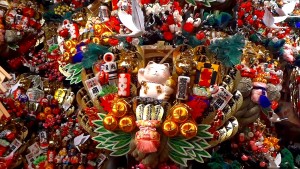
Torinoichi / Festival of the rooster
Torinoichi is a festival that occurs at Shinto shrines on set days in November and is also called “Honorable Rooster (Otorisama)”. Originally, it was a festival at Otori Jinja that celebrated the gods of luck and business prosperity, but now it occurs at other shrines too. Festival days occur two or three times November and are known as the “First Rooster””Second Rooster””Third Rooster”in order. On those days,lots of street stalls selling,among other things,bamboo rakes as giid luck charms are set up in the shrine compound.
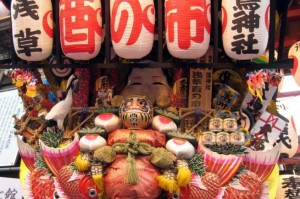
年別アーカイブ: 2014
酉の市
お盆
7月13日から15日、または8月に行われる仏教行事の1つで、先祖の霊を供養するものです。このときに霊が戻ってくるといわれているため、霊が道に迷わないよう家の門口で迎え火をたいたり、室内にちょうちんをともしたりするほか、仏壇をきれいにし、野菜や果物などの供物を飾ります。
そして盆が終わると霊を送り返します。これを精霊送りといい、送り火を門口でたき、供物を川や海に流します。
Bon Festival
Bon Festival is a Buddhist event occurring from the 13th to 15th of July or August to hold a memorial service for the spirits of ancestors. Because the spirits of the dead are said to return at this time, fires are lit at the entrances to homes so the spirits do not lose their way, and , in addition to lanterns being lit inside homes, the Buddhist home alters are tidied up and vegetables fruit are set out as offerings.
And when bon is over, the spirits are sent on their way. This is called the escorting of the spirits and fires to send them on their way are lit at entrances of homes and offerings are floated on rivers and the ocean.

七夕
七夕は7月7日の夜、天の川に隔てられている牽牛星と織女星が、天帝の許しを得て年に一度会えるという中国の伝説からはじまった星を司る年中行事です。 もとは朝廷の貴族の間で行われていた祭でしたが、江戸時代から一般庶民の間に定着しました。6日の夜には、色とりどりの短冊に願い事を書いたり、歌を書いたりして笹につるし、7日の夜に庭先にだします。
Tanabata(July 7)
Tanabata is the Star Festival that occurs on July 7. It is based on the legend in which Altair and Vega, who are split apart on opposite sides of the Milky Way, are allowed to meet once a year on this night by the Emperor of the universe. Originally a festival carried out among the Court nobility, it has since the Edo Period become established among the people at large. On the night of the 6th, people write their wishes or poems on strips of poetry paper of various colors and hang them on bamboo grass; then, on the night of the 7th, they put them out in the garden.
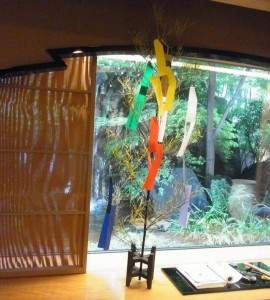
端午の節句/こどもの日
5月5日は男の子の成長を祝う「端午の節句」です。この日は「こどもの日」として国民の祝日にもなっています。男の子のいる家庭では武者や英雄を模した五月人形を飾ったり、屋外にこいのぼりをたてたり、菖蒲やかしわもちを供えたりすることで、その子の立身出世を祈ります。
端午の節句は、古くは災厄を避けるために、菖蒲等の薬草や鳥獣を捕る薬猟の日でした。
室町時代から、紙製のかぶとに菖蒲の花を飾るようになり、江戸時代になって、武者人形やこいのぼりが登場。広く定着したのは明治時代にはいってからです。
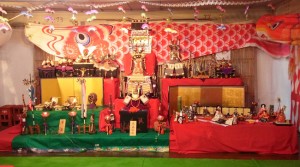
Tango no Sekku
May 5 is a day for boys. Long the Tango no Sekku, it has been officially renamed Children’s Day and made a national holiday. Families with sons buy armored samurai dolls and miniature helmets, hang out koi-nobori, buy irises and kashiwa-mochi, and pray for their sons’ success in life.
Tango no Sekku used to be a day for hunting game and gathering medicinal herbs, such as iris leaves. Shobu in Japanese, the iris has a homonym meaning “military spirit”, from whence came the Muromachi custom of decorating paper helmets with iris leaves.
Samurai dolls and koi-nobori first appeared in the Edo period, but it was not until the Meiji period that these customs became popular nationwide.
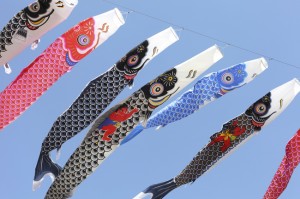
お花見
美しく咲いた桜を観賞し楽しむため公園などに出かけることを花見といいます。日本では、3月・4月に桜の花が満開になると、家族や職場の仲間、友人などと一緒に花見をする習慣があります。 桜の木の下にござなどを敷いて酒を飲んだり食事をしたりして春の到来を楽しみます。
Hanami(Flower-viewing)
Hanami is going out to places such as parks to appreciate and enjoy leisurely the beautiful blooming cherry blossoms. The custom in Japan, in March and April when the cherry blossoms are full bloom, is to do hanami with family,colleagues from work, or friends. People spread a mat under cherry blossoms, drink sake, eat foods,and enjoy the coming of spring.
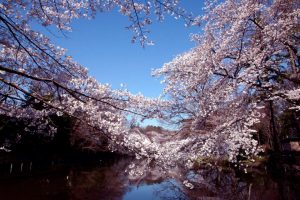
ひな祭り/桃の節句
ひな祭りは、3月3日、女の子の健やかな成長や幸福を願う行事で、桃の節句とも呼ばれます。女の子のいる家庭の多くはひな人形を飾り、桃の花やひなあられ、菱餅、白酒などをひな人形に備えます。 昔は紙で簡単なひな人形を作り、3月3日に川に流していましたが、やがて現在のようなひな人形を飾るようになりました。
ひな祭りの起源は、身の穢れや災いを人形に移し、川に流して厄払いしたという古代の風習にあります。これが、女の子の人形遊び(ひな遊び)と結びつき、江戸時代からは現在に近い形の「ひな祭り」としてとり行われるようになりました。
Hinamatsuri
Hinamatsuri (the Girl’s Festival) ,occurs on March 3 , is a celebration for families with young girls to pray for their good health and happiness. It is also known as momo no sekku (the Peach Festival). Most homes with girls display dolls for the Doll’s Festival and dedicate to them peach blossoms, rice cake cubes, special coloured and diamond-shaped rice cakes,white sake,and other items.
The origin of hinamatsuri is an ancient practice in which the sin of the body and misfortune are transferred to a doll and washed away by setting the doll in a river to drift away. When this practice spread to Japan, it was linked to girl’s playing with dolls and, in the Edo Period, was developed into the hinamatsuri.
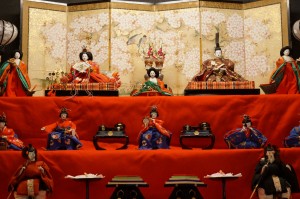
鏡開き
1月11日に鏡餅を割って、お雑煮やお汁粉にして食べます。11日にもなると、鏡餅は固くひび割れてきますが、縁起物なので刃物で「切る」ことを酒、手や槌でたたいて割ります。
Kagami biraki
Kagami-biraki is an event that occurs on January 11 to split open the kagami-mochi and make zoni or shiruko(azuki bean soup) with it. By the 11th, kagami-mochi hardens and cracks,but, since it is a good luck charm, “cutting” it with a sharp edge is avoided and it is split by hand or with a hammer.
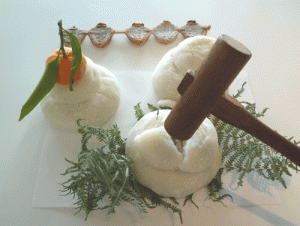
七草粥/人日の節句
1月7日(人日の節句)の朝に、セリやセズナなど「春の七草」をいれてたいたお粥「七草粥」を食べ、1年の健康(無病息災)を祈願します。
Nanakusa-gayu(Seven-herb rice porridge)
On the morning of January 7, kayu(rice porridge) with the seven spring herbs, such as Japanese parsley and shepherd’s purse, are eaten as a custom to pray for the health in the year.
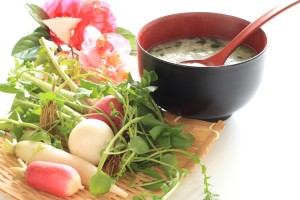
お正月
お正月とは1年の最初の月のことですが、普通1日から7日までの松の内(正月の飾りを飾っている期間)または1日から3日までをこうよびます。
Shogatsu(New Year)
Although shogatsu literally means the first month of the year, it generally indicates matsuno uchi(January 1-7,during which New Year’s decorations are displayed) or first three days of January.
<お正月にまつわること>
■門松
年神様をお迎えするための目印として、新年に家の門や入り口の両側に立てるもの。門松は、松の枝を組み合わせて作った飾りに竹や梅がそえられたものです。松は長生きの象徴でもあります。
Kadomasu
A pair of decorations put at both sides of the gates or entrances of houses in order to summon the year got.Kadomatsu are decorations made with assembled pine branches enhanced by stems of bamboo and sprays of plum trees.Pine is used as a symbol of longevity.
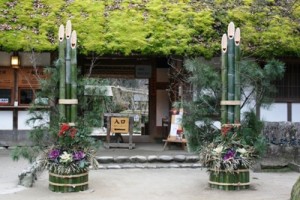
■しめ飾り
しめ縄と同様に、お正月に家の入り口に飾るもので、魔除けの意味があります。わら、紙四手のほか、縁起のよい飾りがついています。正月が終わると門松などと一緒に神社へもっていき、焼いてもらいます。
Shimekazari
A decoration displayed at the entrances of houses during the New Year like shimenawa as a charm against evil spirits.Straw,kamishide and good luck charms are attached.When the New Year period ends, this Shimekazari , Kadomatsu and the othe decorations are taken to Shinto shrines and burned.
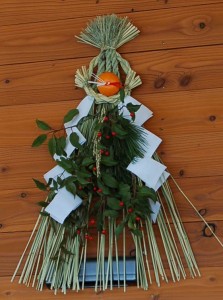
■しめ縄
正月に家の入り口にかけて、不浄なものの侵入を防ぐもの。
Shimenawa
A decoration put over the door of a house during New Year period to keep the evil out.
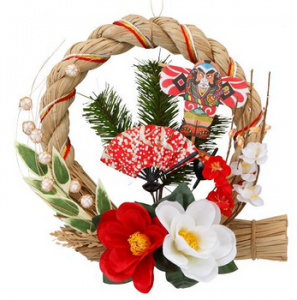
■鏡餅
大小の丸い餅を2つ重ね、神様のお供えするもの。昔、鏡は丸く、人の魂を映す神聖なものとされていたことに由来します。
Kagamimochi
A set of two rice cakes, one large and one small, stacked one on top of the other as an offering to the gods. In old times, all mirrors(kagami) were round and considered sacred objects that reflected one’s spirit.
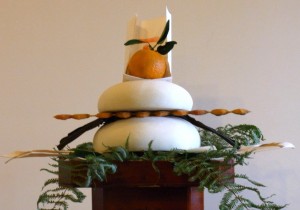
■初日の出
神道では太陽を最も神聖なものであるとされていることから、新年最初の日の出を拝み、一年の健康と幸運を祈願します。
Hatsuhinode(the sunrise on New Year’s Day)
As the sun is considered to be the most sacred object in Shinto, people worship the sunrise on New Year’s Day to pray for health and happiness in the new year.
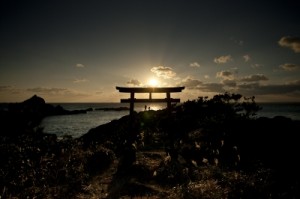
■初詣
新年になって初めて寺社にお参りし、その年の健康と幸運を願うもの。
Hatsumode
During the New Year period, people go for the first temple or shrine visit of the year to pray for health and happiness in the new year.
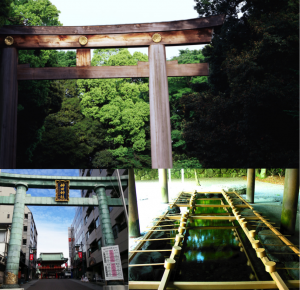
■初夢
正月2日の夜に見る夢。「一富士二鷹三なすび」というのがめでたいとされる夢の順番です。
Hatsuyume
Hatsuyume is the dream that occurs the night of New Year’s Day to the morning of the 2nd. A saying states that the best order for the dream’s subject matter is:”first,Mt. Fuji;second,hawks;third,eggplants.”
■お屠蘇
その年の邪気をはらい、長寿を祈願して年始に飲むお酒。
Toso
A special sake people drink on the New Year’s Day to prevent illness in the new year and pray for the longevity.
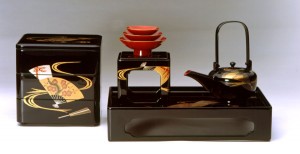
■お雑煮
雑煮は、餅や野菜を入れた汁で、新年を祝うためにお正月に欠かせない料理の1つです。関東地方の雑煮は四角い餅を入れたすまし汁仕立て、関西地方の雑煮は丸い餅を入れた味噌仕立てというのが一般的です。味付けや中に入れる具は、地方や家庭に寄って異なるのが雑煮の特徴です。
Zoni(Soup with rice cakes and vegetables)
Zoni is a soup with rice cakes(mochi) and vegetables and is an essential dish for celebrating the New Year. In the Kanto area, zoni is generally prepared as a clear soup with square kochi, while Kansai , it is made with bean paste and round mochi.
But the seasoning and othe ingredients are different according to each region and household.
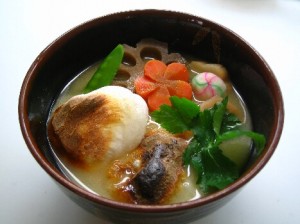
クリスマス・年末年始の贈り物に、和のアクセサリー「豆銀」を
当社代表神森がプロデュースする和のアクセサリー「豆銀」は、「気軽に手に取り、身に付けることができ、和文化の魅力を身近に感じられるようなアクセサリーを」目指し誕生しました。
本シリーズは、古来より日本人が親しんできた「桜」と「千鳥」という和のモチーフです。アクセサリーはもちろん、豆型・着物地のアクセサリーケース、パッケージにもこだわりをもちつくらせていただきました。
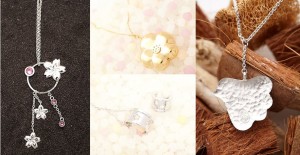
大切な人(家族・恋人・友人)への贈り物に、自分へのごほうびに。和のアクセサリー「豆銀」を通じて、日本文化を身近に感じていただけましたら幸いです。
今年のクリスマスプレゼントに、和のアクセサリー「豆銀」はいかがでしょう?
https://jtcl.co.jp/news/mamegin/
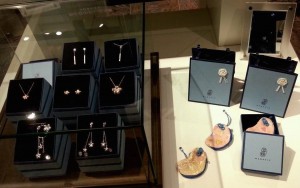
=====
※アクセサリーについてのお問い合わせ先: info@jtcl.co.jp
※ご注文・ご質問はお問い合わせフォームから受け付けさせていただきます。
=====
<豆銀(まめぎん)について>
「気軽に手に取り、身に付けることができ、 和文化の魅力を身近に感じられるようなアクセサリーを」「豆銀」はそんな思いから誕生しました。
「豆」は「ちいさくてかわいいもの」。
「豆銀」は江戸の人たちが巾着などに入れて使っていた貨幣、「豆板銀」にもちなんでいます。
=====
<桜・千鳥モチーフにこめられた想い>
*桜:日本人の精神のシンボル・神様が宿る
桜は公式には国花ではないものの、日本人にとって特別な存在です。
「さくら」という名前の由来は、「咲く」に複数を意味する「ら」を加えたものとも、春になると里にやってくる稲(サ)の神が憑依する座(クラ)だから「サクラ」になったともいわれています。
伝統文化においては、桜を人に見立てた能の「西行桜」、歌舞伎の名作「義経千本桜」など。音楽においては、筝の手ほどきとして作られた『さくらさくら』、滝廉太郎の歌曲『花』、長唄の『元禄花見踊』など。絵画においては、葛飾北斎による桜と富士の絵。俳句においては、松尾芭蕉が桜をテーマに詠んだ句「さまざまの事おもひ出す桜哉」など、「桜」は、古くから日本人の精神のシンボル・春の象徴・花の代名詞として、幅広く和文化の題材としてとりあげられています。
*千鳥:目標達成・勝運祈願のお守りの意味も
『千鳥=千取り』という語呂合わせもあって、『勝運祈願』や『目標達成』の意匠としても使われてきました。そんな縁起のよい千鳥を身につけることでファッションと同時にお守りの意味も。
=====
・ネックレスはお好みでチェーンの長さを調整できます。
・全てのアクセサリーには、1点1点異なる豆型の着物生地のアクセサリーケース(桜柄・千鳥柄)・水引がついたオリジナルの紙袋がついています。
=====
■デザイン:トミタ・ジュン(建築家/プロダクト・グラフィックデザイナー、アティモント・デザイン研究所 代表取締役、京都造形芸術大学プロダクトデザイン学科准教授)
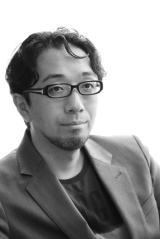
東京電機大学未来科学部建築学科非常勤講師。慶應義塾大学SFC研究所所員(坂井直樹研究会)ニューヨーク大学アート学科(NYU)で学ぶ。卒業後、緑との共生を唱えるグリーン建築で世界的な建築家、エミリオ・アンバースに師事し建築プロジェクトなどに参画。
96年ペットボトル「アクアブロック」でアメリカの権威ある賞、IDデザインのグランプリ受賞。99年には㈱アティモント・デザイン研究所を設立。
プロダクト、グラフィック、建築など幅広い分野でデザイン活動を展開している。
ニューヨーク大学美術学科卒/一級建築士
父の富田仁秀は仁和寺の御用達陶芸家で、元たち吉社長。祖父は元たち吉会長の冨田忠次郎。
著書『センスいいね!と言われる人の思考術』『センスの磨き方』
■プロデュース:神森真理子
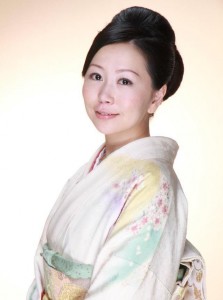
ジャパントラディショナルカルチャーラボ株式会社代表取締役。
慶應義塾大学卒業。パリ第三大学で映像・アートビジネスの勉強をし、松竹株式会社に入社。ベルギー・フランス生活を通じ、「日本文化の活性化」という生涯の目標を見出し、
会社員としてマーケティング・PRの仕事に従事しつつ、日本文化の伝道師として、日本文化・食・アートの魅力を発信するイベント企画・プロデュース・執筆・講演などを多数手掛ける。日本の結婚式を通じ、日本文化の魅力を発信する情報サイト「和結」を運営。
日本文化に関する多数の企画・コンサルティングプロジェクトに従事した後、独立しジャパントラディショナルカルチャーラボ株式会社 代表取締役に就任。
日本文化関連の企画・コンサルティング、和の婚礼、日本文化を学べるwebスクール「nippon labo」などの事業を展開。
日本酒「笑酒来福(しょうしゅらいふく)」、和のアクセサリー「豆銀(まめぎん)」など、和の商品企画・開発も手がける。+ART CLUB/「食とアートの会」主宰。
※アクセサリーについてのお問い合わせ先: info@jtcl.co.jp
